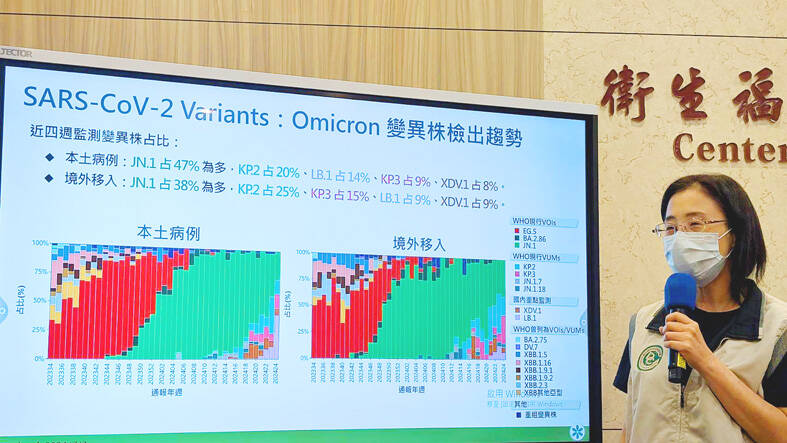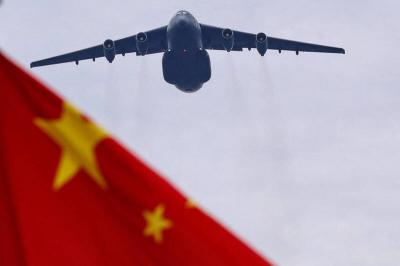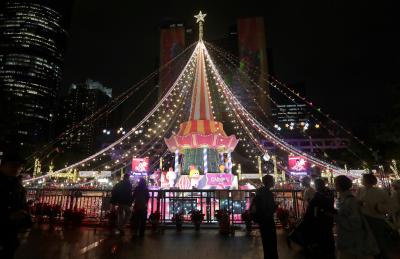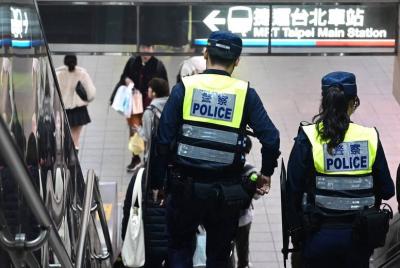The Centers for Disease Control (CDC) yesterday reported 932 hospitalizations due to COVID-19 and 64 related deaths for last week, adding that the number of people who had contracted new SARS-CoV-2 subvariants KP.2 and LB.1 has increased.
The number of people hospitalized due to COVID-19 increased from 815 in the previous week to 932 last week, while 90 percent of the 64 deceased were aged 65 or older, CDC physician Lin Yung-ching (林詠青) said.
JN.1 was still the dominant variant among local and imported cases in the past four weeks, while KP.2 was the second-most common, Lin said.

Photo: CNA
Cases with the LB.1 subvariant have also risen significantly, he said.
The growth rate of COVID-19 hospitalizations had dropped from 90 percent to 30 percent in the previous weeks, and then to 14 percent last week, indicating that the recent COVID-19 wave could peak in the middle of this month and cases might gradually begin to fall afterward, CDC Deputy Director-General Tseng Shu-hui (曾淑慧) said.
However, aside from the dominant subvariants JN.1, KP.2 and KP.3 circulating in many countries, the CDC also observed a rapid growth in LB.1 cases, and while LB.1, KP.2, and KP.3 are all descendants of the earlier JN.1 variant, LB.1 exhibits higher infectivity and greater immune escape than KP.2 and KP.3, Tseng said.
The XBB.1.5-adapted COVID-19 vaccines are still effective, but while people’s willingness to get vaccinated has increased in the past week, the overall coverage rate is still relatively low at 11.55 percent, she said.
The first and second dose coverage rates among elderly people are only at 20.89 percent and 1.97 percent respectively, she added.
One of the COVID-19 related deaths last week was a teenage boy with epilepsy, who did not receive the updated vaccine, Lin said.
He developed encephalitis and septic shock after a recent infection last month, and died of multiple organ failure one day after being rushed to the hospital for a high fever, convulsion and difficulty breathing, he said.
Meanwhile, 101,091 hospital visits for flu-like illnesses were reported last week, and the main circulating flu virus strain in the past four weeks was influenza A(H1N1), CDC Epidemic Intelligence Center Deputy Director Lee Chia-lin (李佳琳) said.
Sixty-eight severe flu complications and 16 flu-related deaths were also reported last week, adding to a total of 1,212 severe cases and 230 deaths in this flu season, which began in October last year, Lee said.
The number of hospital visits increased by 4 percent from the previous week and is estimated to have reached a peak, which is likely to be followed by a plateau in the coming weeks, so cases might start to drop in the second half of this month, Tseng said.
As flu re-entered an epidemic period, the CDC on Wednesday last week announced the expanded use of antiviral drugs for flu treatment, enabling doctors to prescribe the drugs to patients with flu-like symptoms and have family members, coworkers or classmates diagnosed with the flu.
The centers yesterday said the expanded use will be extended until July 31.
One of the flu-related deaths last week was a three-year-old girl, who did not have underlying health conditions and was vaccinated in October last year, but began coughing and had a runny nose last month and received treatment at a clinic, Lin said.
However, as her symptoms worsened and she developed a high fever of 39°C a week later, she was taken to an emergency room, before being sent home to rest, he said.
The girl later developed altered consciousness, a high fever, chills and convulsions, and was found to be in shock when rushed to a hospital, he said.
The girl tested positive for influenza A infection and was admitted to an intensive care unit, but she died of flu-induced encephalitis and myocarditis the next day, Lin said.
Flu-induced pneumonia is more common, but complications of encephalitis and myocarditis at the same time are relatively rare, he said.

Beijing could eventually see a full amphibious invasion of Taiwan as the only "prudent" way to bring about unification, the US Department of Defense said in a newly released annual report to Congress. The Pentagon's "Annual Report to Congress: Military and Security Developments Involving the People's Republic of China 2025," was in many ways similar to last year’s report but reorganized the analysis of the options China has to take over Taiwan. Generally, according to the report, Chinese leaders view the People's Liberation Army's (PLA) capabilities for a Taiwan campaign as improving, but they remain uncertain about its readiness to successfully seize

Taiwan is getting a day off on Christmas for the first time in 25 years. The change comes after opposition parties passed a law earlier this year to add or restore five public holidays, including Constitution Day, which falls on today, Dec. 25. The day marks the 1947 adoption of the constitution of the Republic of China, as the government in Taipei is formally known. Back then the Chinese Nationalist Party (KMT) governed China from Nanjing. When the KMT, now an opposition party in Taiwan, passed the legislation on holidays, it said that they would help “commemorate the history of national development.” That

Taiwan has overtaken South Korea this year in per capita income for the first time in 23 years, IMF data showed. Per capita income is a nation’s GDP divided by the total population, used to compare average wealth levels across countries. Taiwan also beat Japan this year on per capita income, after surpassing it for the first time last year, US magazine Newsweek reported yesterday. Across Asia, Taiwan ranked fourth for per capita income at US$37,827 this year due to sustained economic growth, the report said. In the top three spots were Singapore, Macau and Hong Kong, it said. South

Police today said they are stepping up patrols throughout the Taipei MRT system, after a social media user threatened to detonate a bomb at an unspecified station this afternoon. Although they strongly believe the threat to be unsubstantiated, Taipei Metro police and the Railway Police Bureau still said that security and patrols would be heightened through the system. Many copycat messages have been posted since Friday’s stabbing attacks at Taipei Main Station and near Zhongshan MRT Station that left three dead and 11 injured, police said. Last night, a Threads user in a post said they would detonate a bomb on the Taipei